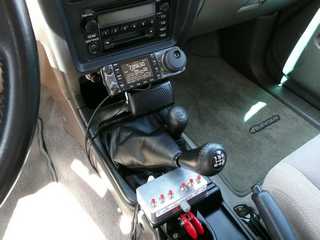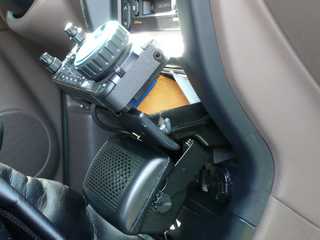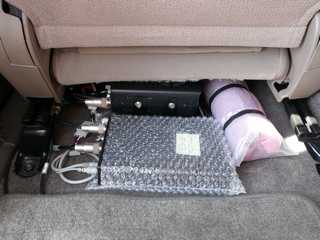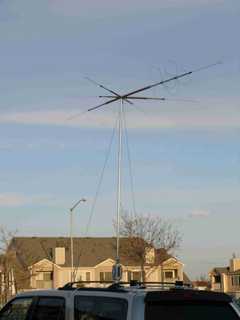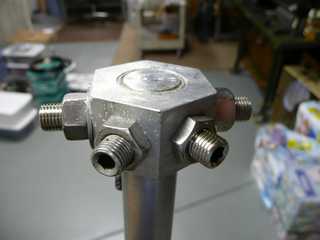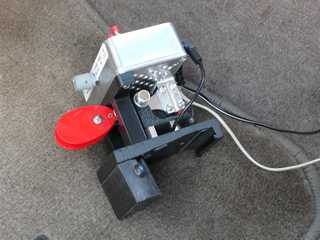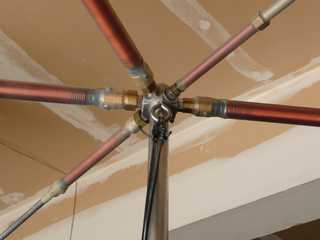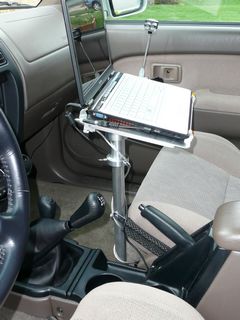The pictures on this page show the current mobile installation in my 2000 Toyota 4Runner. I have made several changes in the past 5 years which were the result of over 40,000 mobile contacts of which 75% were CW and 25% were SSB. Most of these pictures were taken in late 2007 and early 2008. The high resolution (1200x900) version of all the pictures may be downloaded in a single zipfile (1MB) by clicking here.
Click on any pic for higher resolution image
Page content last updated May 6, 2009 (orig. content 2008)
Copyright © 2008-2009 Larry Benko, W0QE
The pictures in this area show the radio installation. The
original installation was for an Icom 706mkIIG and the space
where the ashtray was located seemed to be perfect. A
quick trip to the Toyota dealer produced a sacrificial ashtray
insert for about $20. The side picture shows a custom fit
chunk of wood that is screwed into the ashtray which then
provides a surface to mount the bracket for the radio face.
Underneath the ashtray are 2 neoprene wedges that secure
the open ashtray and the radio face never moves or vibrates
loose even on 4WD backroads in the mountains. Removal is
as easy as pulling out the 2 wedges and pushing down on the
lid of the ashtray which takes about 30 seconds. The side
view picture shows a piece of blue plastic which was needed
for the Icom 7000 which has a face that is just slightly
different in shape from the 706.
The radio mounts under the driver's seat and when the seat
is pushed back is completely captured. The picture shows
the radio with an external LDG Z11Pro tuner, used for 40m
SSB and 17m, and a 2 Farad capacitor (in plastic wrap in
case of a leak). The 2F capacitor allows for longer operating
with the engine stopped and totally eliminates alternator
noise from the radio. The resistance of the DC wire from the
battery at .01 ohm and the the 2F capacitor form a low pass
filter with a 3dB roll off frequency of 8Hz. Also the 2F
capacitor smoothes out the current draw from the battery
so that the wiring only needs to provide the average current
and not the peak current resulting in the radio not resetting
when running with the engine off.
Additionally for contests, when my wife drives (and I do
appreciate it), I temporarily remove the glove box and
mount an Icom 746Pro with a special bracket in that space.
The 746Pro is really a better radio than the 706 or 7000 in a
contest. This picture was taken in May 2007 before I
purchased the IC7000 and shows the original IC706mkIIG in
the ashtray mount. The keyer mounts to the top of the
IC746Pro using a couple of existing screw holes. Note that
the radio clears the air bag and even if the vehicle rolls over
the radios remain captive.
The 2 pictures below and the top right picture above show how the paddle is mounted in one of the cup holders (I use the cup holders behind the console for drinks) with the keyer on top of the paddle. The position is perfect as I can wedge my arm between the seat and the cosole and can send good CW even on bumpy roads. A piece of delrin locks the paddle in place and a 1/4 turn with a screwdriver allows instant removal. Making 1000 mobile contacts in a single day requires a good comfortable operating position.
The 3 pictures to the right and the group below show the
antenna installation. Several different antennas have been
used but I have settled on a home made multiband antenna
based on a W9UCW design. This antenna is not as frequency
agile as a large screwdriver antenna but can do band changes
instantly. A mobile trip from Colorado to Virginia at the
beginning of 2008 resulted in 6335 contacts from 163
counties and according to the log nearly 1500 band changes.
The antenna brackets are made from 1/4" 6061-T6
aluminum and mount directly to the roof rack with 6x1.0mm
SS screws. Each side of roof rack mounts with five
6x1.0mm screws through the roof to a backing bar above
the headliner inside the vehicle. All the threaded holes in both
backing bars had the paint cleaned from the threads with a
tap and SS screws with Penetrox on the threads were re-
installed. The connection to vehicle ground is very good and
short. Then the brackets were connected to the cross bar
on the roof rack via some homemade delrin brackets for
lateral support. This scheme worked fine when I was running
Hamsticks but with the big antenna I added a 5/8" 2024
hardened aluminum cross bar to minimize sideways flex with
the big antenna. This has worked well when travelling
75mph on I-25 in Wyoming heading north with a 70mph
crosswind from the west.
The antenna base is a homemade piece of delrin machined at
an angle (so the antenna is vertical) to a 1" diameter solid
stud made of 6061-T6 aluminum. Notice the drain holes in
the bracket and the stud is connected with a 5/8" grade 8
bolt and a small 1/4x20 screw to prevent rotation.
A mount with 4 springs (with internal continuity wires)
connects to the 1" stud and is easily removed in a minute or
less for garaging the vehicle. A 72" mast (plus springs) of
7/8" 6061-T6 connected to a 1.5" piece of 6061-T6 hex
aluminum yields a 76" high mast with some flex to mount up
to 6 resonators. The homemade hex adapter is tapped with
standard 3/8-24 setscrews which are how the resonators
mount. The antenna is guyed to the front of the roof rack
with two 1/16" kevlar cords and some bungie cords that
provide a very nice shock absorber mecahanism. I have had
this antenna over many Colorado 4WD passes in terrible
conditions and has never failed.
The antenna shown with 6 resonators covers 80m to the
rear (12 KHz 2:1 SWR bandwidth), 40m to the front (80
KHz 2:1 SWR bandwidth), 30m, 20m, 15m, and 10m. A 1.5
uH inductor to ground wound on a T94-6 torroid matches
the antenna to less than a 1.3:1 SWR on all bands.
Additionally this particular resonator placement produces a
spurious resonance near 18MHz. allowing 17m operation
with a 2.5:1 SWR or can be reduced with the LDG tuner.
Click on any pic for higher resolution image
2009 MARAC, 7QP, and NEQP Contest (May 2-3, 2009)
For the past several years I have done this contest weekend from somewhere in Kansas or Nebraska and usually run into lightning or tornadoes. I was even hit by lightning a few years ago in Dundy County, NE which needless to say ruined the weekend and the radios. While operating is an awful lot of fun so is changing something so I decided to operate from the 7th call area for the 7QP part of the weekend and decided to run the contests with a laptop computer meaning that I would use the IC-7000 rather than the IC-746Pro for the radio due to space. I started the weekend in northwest Colorado an drove through SW Wyoming, NE Utah, eastern and central Idaho, northern and eastern Utah, and finally back home through Colorado. I operated from 39 different counties during the contest(s), drove 1820 miles (including getting to and from the starting and ending locations), and made about 1500 contacts. The weather was rainy with some light snow and the scenery was gorgeous. For those who have never done mobile contesting there are challenges but it is extremely addictive.
Click on any pic for higher resolution image
Click on any pic for higher resolution image
